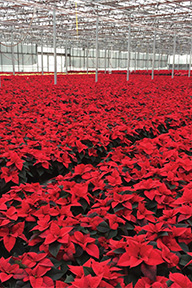Protecting Poinsettias
{SPONSORED} It is time to start gearing up for poinsettia production. Poinsettias can be susceptible to a variety of diseases and pests, like Botrytis and whiteflies, so preventive actions are recommended to ensure high-quality crops.
Keep Whiteflies Away 
Poinsettias tend to attract whiteflies more than any other pests. Adult and immature whiteflies have piercing-sucking mouthparts that are inserted into the phloem and extract plant sap, which affects plant vigor. Nymphs cause most damage, including:
- Reduced leaf expansion
- Chlorotic spots on the top sides of leaves
- Leaf discoloration or silvering
- Presence of honeydew secretions on leaves that can result in black sooty mold
Whitefly populations can build quickly, so scouting on a weekly basis is essential. It is helpful to examine the undersides of leaves for larvae and nymphs with a hand lens.
Mainspring® GNL insecticide, powered by a novel active ingredient in IRAC Group 28, is an excellent option for long-lasting control of whiteflies. For long residual control, apply Mainspring GNL as a drench 2-3 weeks after the crop is pinched and before whitefly populations can build. This allows for optimal uptake of the product since the crop is well-rooted after transplanting.
Gain Control of Common Diseases
The most common diseases poinsettia growers may encounter are:
Alternaria leaf spots
Alternaria leaf spots begin as small lesions with a tan center and dark margins. They are somewhat rounded and irregular in shape, surrounded by a chlorotic tissue. They are typically found on the lower leaves and can be mistaken for Xanthamonas sp. leaf spot. As the infection spreads, the leaf will become chlorotic and drop from the plant.
Botrytis
Botrytis thrives in cool, humid environments and can be particularly problematic in the later part of poinsettia production. Initial infections cause water-soaked, V-shaped lesions on the foliage and bracts. Once established, the mold can quickly spread throughout the crop and production area.
Powdery mildew
Powdery mildew can be a problem on poinsettia produced in cooler regions of the country. Powdery mildew fungi form white, talcum-like spots on leaves, stems and flowers. Over time, they increase in size and number to cover the plant’s surface, reducing growth and causing leaves to turn yellow, brown and then drop.
Providing a clean, dry growing environment and checking incoming plants for symptoms are two steps to help prevent disease. Applying a broad-spectrum fungicide, such as Mural®, can help prevent ornamental diseases at any stage in production, from propagation to shipping. As an advanced generation SDHI, Mural has shown superior systemic control compared to strobilurin fungicides. This makes it an excellent choice for combatting diseases like Botrytis, leaf spots and powdery mildew.
Syngenta has developed a full agronomic program for poinsettia production to help you through all phases of production. This program includes a product rotation guide with a built-in resistance management strategy, as well as cultural tips. To help ensure a healthy crop this season, download our poinsettia agronomic program at www.GreenCastOnline.com/Solutions.
©2020 Syngenta. Important: Always read and follow label instructions. Some products may not be registered for sale or use in all states or counties and/or may have state-specific use requirements. Please check with your local extension service to ensure registration and proper use. GreenCast®, Mainspring®, Mural® and the Syngenta logo are trademarks of a Syngenta Group Company.


 Video Library
Video Library 




















